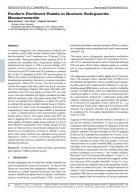Details
- Identification
- ISSN 1977-5296, DOI: 10.3011/ESARDA.IJNSNP.2018.11
- Publication date
- 1 December 2018
- Author
- Joint Research Centre
Description
Volume: 57, December 2018, pages 60-65
Authors: Elisa Bonner1, Tom Burr2, Claude Norman2
1Colorado State University, 2Safeguards Information Management, International Atomic Energy Agency (IAEA)
Abstract: In nuclear safeguards, two measurement methods are sometimes used to infer nuclear material mass. Suppose that the method 1 and 2 estimates are 1.0 kg and 1.5 kg, respectively. Using generalized least squares (GLS) to combine two estimates has a long history dating to its development by Gauss in 1795. In some settings, GLS exhibits curious behaviour, as described in Peelle’s Pertinent Puzzle (PPP) where the GLS estimate to combine the 1.0 and 1.5 estimates is 0.88. PPP was introduced in 1987 in the context of combining two or more estimates of fundamental parameters that arise in nuclear interaction experiments. When PPP occurs, the GLS estimate is outside the range of the data, which has led to concerns that GLS estimation is flawed. This paper describes GLS estimation and PPP and points out that PPP can only occur if the two estimates are highly correlated and have different variances. Next, this paper shows that PPP can arise in an example from safeguards, in which the goal is to estimate the average nuclear material mass in N items. A sample of n1 items from the population of N items is measured by a lower-quality assay method; a subsample n2 of the n1 sampled items is also measured by a higher quality assay method. This paper shows that PPP can arise in applying GLS to combine the estimates from the lower-quality and higher-quality assay methods, for any of three different measurement error models. Model A is the same as that used by a conventional safeguards model. Model B is a modification of model A. Model C arises when both assay methods are calibrated using reverse regression, which in recent uncertainty quantification studies has been shown to outperform classical regression followed by inversion.
Keywords: combining two measurements, generalized least squares, Peelle’s pertinent puzzle
Reference guideline:
Bonner, E., Burr, T., & Norman, C. (2018). Peelle’s Pertinent Puzzle in Nuclear Safeguards Measurements. ESARDA Bulletin - The International Journal of Nuclear Safeguards and Non-proliferation, 57, 60-65. https://doi.org/10.3011/ ESARDA.IJNSNP.2018.11

